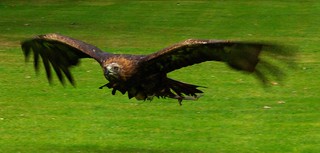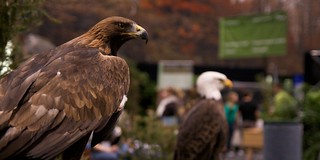Most of the time, when we publish stories involving GPS tracking and wildlife, the stories tend to have a depressing angle. Most of the time this technology is used to help protect endangered species. These stories often involve dwindling wildlife populations, usually partly or wholly caused by human interference. We’ve written about destroyed habitats and majestic beasts being picked off by poachers for profit. Today’s wildlife tracking tale is much more upbeat. WIth the help of GPS technology and remote baited cameras, researchers have discovered that golden eagles are thriving in the eastern United States.

CC Image courtesy of jack_spellingbacon on Flickr
Prior to the study, it was believed that eastern golden eagles spent the winter north of the border, in Canada. The elusive birds were rarely seen in the U.S. during the winter, and any that were spotted, were assumed to be migrating north to Canada with the rest of the eastern golden eagle population. However, eight years of GPS tracking and three years of 250 motion-activated baited camera sites revealed that these eagles spend the winter months all across the eastern region of the U.S., as far west as Michigan and Indiana, stretching all the way down to Alabama. The cameras revealed that the majority of birds spend their winter in the western counties of VIrginia and in the eastern highlands of West Virginia.
“That’s still the area where the densest populations of eastern golden eagles are found in winter,” explained Todd Katzner, a WVU research assistant professor who coordinated the study with Appalachian Eagles and the Eastern Golden Eagle Working Group. “We started to see that the winter distribution is a lot bigger than we had thought… It’s amazing! They’re on the bait from Maine to Alabama and most of the states in between. They’re in Michigan, Indiana, Ohio and Tennessee. They’re everywhere!”
“There are some birding records in the east where golden eagle sightings have been recorded, but this is the first systematic look at their distribution and population,” said Katzner. “They’re showing up in greater numbers, and over a much larger range than expected.” Golden eagles tend to be elusive birds of prey, making them difficult to monitor with the the human eye, despite their massive wingspan, which can get up to seven feet. With tracking and camera technology, researchers have grasped a much better understanding of the eastern golden eagle population.
Another factor that makes eastern golden eagles, in particular, difficult to study, is that their numbers are thought to be much smaller than those in the western regions of the U.S. and Canada. It is estimated that there are around ten times as many golden eagles in the west than there are in the east. With the help of motion-censored cameras, baited with road-killed deer, researchers are getting a much better picture of the density of golden eagles in the east. “Golden eagles were seen at a majority of our sites,” Kieran O’Malley, a study participant and biologist with the state Division of National Resources. “I had one in my back yard,” Katzner said. “We photographed a golden eagle there this year.”

CC Image courtesy of qmnonic on Flickr
As if there weren’t enough obstacles to studying eastern golden eagles, these birds generally prefer solitude. They do also stay with the same mate for several years, and sometimes even a lifetime, but when out hunting or when not nesting, golden eagles are on their own. “Unlike bald eagles, goldens don’t get together in big groups,” O’Malley added. “They prefer to live in areas that are more remote than the places bald eagles live.”
“We’re looking at wintering populations and population density,” O’Malley explained. “We have really good numbers of golden eagles wintering in West Virginia. The highest density anywhere is in the highlands of West Virginia and western Virginia, since they prefer forested uplands away from a lot of human activity.” One factor attributed to the abundant golden eagle population in the mountains of West Virginia and Virginia, is the white-tail deer in the area. Over the last 40 years, the white-tail deer population has been swelling, providing plenty of winter-killed and road-killed meals for the eagles.
The research team has compared some of the DNA samples from the eastern golden eagles with the western population. It seems that there are not many differences between the two other than region. “Other than the fact that one group lives in the east and the other lives in the west, there doesn’t seem to be much difference between them,” Katnzer said. It is currently estimated that the eastern population is around 2,000 to 5,000 eagles. “We’ll be doing some computer modeling, but right now, I’m starting to think the population is on the high side of those estimates,” said Katnzer.
The cameras have captured a wide variety of wildlife in the area, spawning a secondary study of spotted skunks. “We started seeing spotted skunks, which have become very uncommon in the state, turning up in the photographs,” O’Malley added. “We’ve been able to add to their range… They’re a lot more widespread than we thought, but still not very abundant.” Other wildlife seen in the region include foxes, raccoons, blue jays, fishers, coyotes, titmice, ravens, crows, wood rats, owls and bobcats.
GPS Tracking Study Reveals Surprise About Eastern Golden Eagles

No comments:
Post a Comment